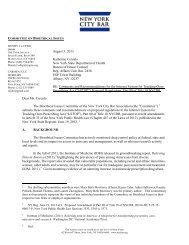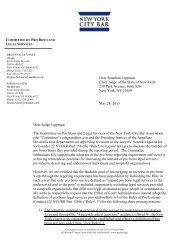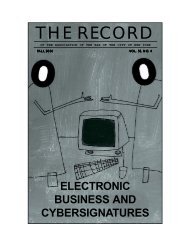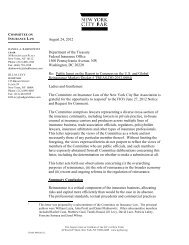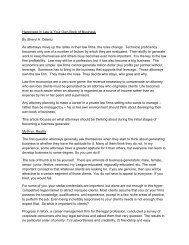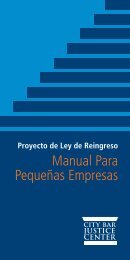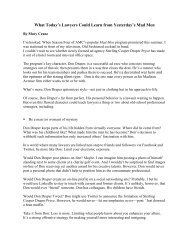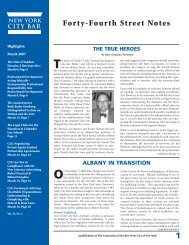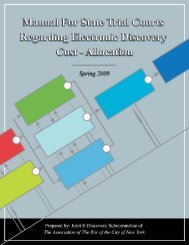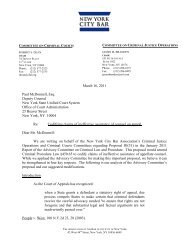2007 Issue 1 - New York City Bar Association
2007 Issue 1 - New York City Bar Association
2007 Issue 1 - New York City Bar Association
Create successful ePaper yourself
Turn your PDF publications into a flip-book with our unique Google optimized e-Paper software.
J U D I C I A L S E L E C T I O N T A S K F O R C E<br />
Chief Justice Judith Kaye appointed the 29-member Feerick Commission,<br />
headed by John Feerick, former Dean of Fordham Law School (and a<br />
former President of the <strong>Association</strong>), and charged it with the mandate<br />
“to provide <strong>New</strong> <strong>York</strong>’s courts with a blueprint for preserving the dignity<br />
of judicial elections and promoting meaningful voter participation, which<br />
will serve to reaffirm public trust in our judiciary.” 2 Abiding by its mandate,<br />
the Feerick Commission only examined the election system—and<br />
not other judicial selection mechanisms—and issued its recommendations<br />
on improvements that could be brought to that system. 3<br />
In January 2006, the landscape significantly changed with the issuance<br />
of Judge Gleeson’s decision in Lopez Torres, holding the current judicial<br />
convention process for selecting <strong>New</strong> <strong>York</strong> Supreme Court Justices<br />
unconstitutional and providing for primary elections in the absence of<br />
any action by the Legislature. The issue of judicial selection was thus transformed<br />
into a matter of immediate and significant consequence to the<br />
State. Now that Judge Gleeson’s decision has been affirmed by the Second<br />
Circuit, judicial selection must be a leading issue before the Legislature.<br />
The <strong>Association</strong>, for more than a century, has played a very active<br />
role in the judicial selection debate and has long adhered to the position<br />
that the most appropriate method for selecting <strong>New</strong> <strong>York</strong> State’s judiciary<br />
is an appointive system. In October 2003, a task force appointed by the<br />
<strong>Association</strong> issued a report firmly supporting the <strong>Association</strong>’s long-standing<br />
position in favor of a commission-based appointive system and recommending<br />
that independent and diverse citizen screening commissions review candidates’<br />
qualifications and forward the candidacy of only the most highly<br />
qualified applicants for appointment by an accountable elected official. 4<br />
In order to best fulfill its mandate of issuing recommendations improving<br />
<strong>New</strong> <strong>York</strong>’s judicial selection system, the present Task Force created<br />
three subcommittees: (i) the Impact on Minority Candidates Subcommittee,<br />
(ii) the Lopez Torres Subcommittee and (iii) the Improvement<br />
of the Elective System Subcommittee.<br />
2. Press Release, <strong>New</strong> <strong>York</strong> State Unified Court System, Commission to Foster Public Confidence<br />
in State’s Elected Judges and the Electoral Process (Apr. 16, 2003), available at http://<br />
www.nycourts.gov/press/pr2003_08.shtml.<br />
3. See generally <strong>New</strong> <strong>York</strong> State Commission to Promote Public Confidence in Judicial<br />
Elections, Final Report to the Chief Judge of <strong>New</strong> <strong>York</strong> State (Feb. 6, 2006).<br />
4. See generally Judicial Selection Task Force of the <strong>Association</strong> of the <strong>Bar</strong> of the <strong>City</strong> of <strong>New</strong><br />
<strong>York</strong>, Recommendations on the Selection of Judges and the Improvement of the Judicial<br />
System (2003) (“Task Force 2003 Report”), available at http://www.abcny.org/pdf/<br />
Judicial%20selection%20task%20force.pdf.<br />
T H E R E C O R D<br />
92



